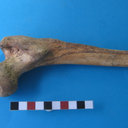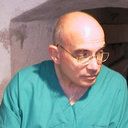RICKETS AT THE MEDICI COURT OF FLORENCE: THE CASE OF DON FILIPPINO (1577-1582).
Λέξεις-κλειδιά
Αφηρημένη
Among the children found in the crypt of the Grand Duke Giangastone in S. Lorenzo Basilica (Florence), the skeletal remains of a 5-year-old child still wearing his fine high social status clothing were recovered. This child of the Medici family was identified as Don Filippino (1577-1582), son of the Grand Duke Francesco I (1541-1587) and Giovanna from Austria (1547 - 1578). The prince showed several pathological deformities of the cranial and post-cranial skeleton, including enlargement of the cranium, thinning of the cranial vault bones (craniotabes), platybasia and marked bending of femora, tibiae and fibulae. Differential diagnosis suggests that Don Filippino was affected by rickets. The occurrence of this metabolic disease related to vitamin D deficiency in a Renaissance high social class individual can be explained by the practice of very prolonged breast-feeding, up until two years of age. Maternal milk contains insufficient vitamin D ratios and retarded weaning severely exposes children to a higher risk of developing rickets, especially if dietary habits are combined with inadequate exposure to sunlight. Historical sources describe Don Filippino as frail and sickly, with frequent illnesses and persistent slight fevers, and it can be supposed that the child was frequently confined indoors, especially in the cold season. Integration of osteoarchaeological evidence with historical documentation suggests that bone lesions observed in the skeletal remains of Don Filippino are compatible with a diagnosis of rickets, caused by the custom of prolonged breast-feeding associated with inadequate sunlight exposure to sunlight. Historical sources describe Don Filippino as frail and sickly, with frequent illnesses and persistent slight fevers, and it can be supposed that the child was frequently confined indoors, especially in the cold season. Integration of osteoarchaeological evidence with historical documentation suggests that bone lesions observed in the skeletal remains of Don Filippino are compatible with a diagnosis of rickets, caused by the custom of prolonged breast-feeding associated with inadequate sunlight exposure.




